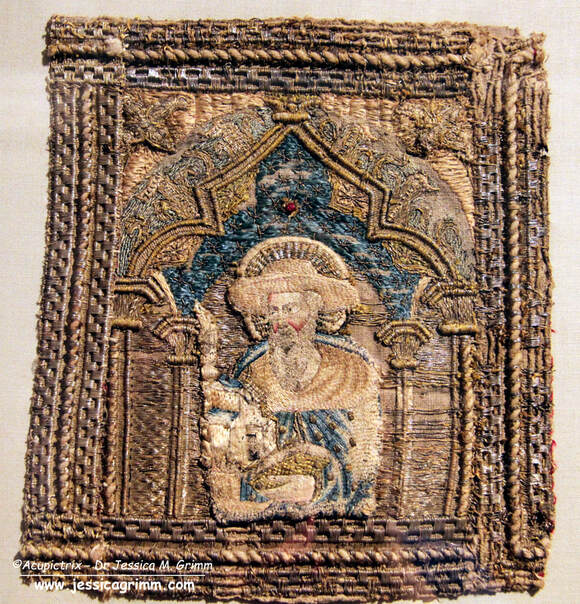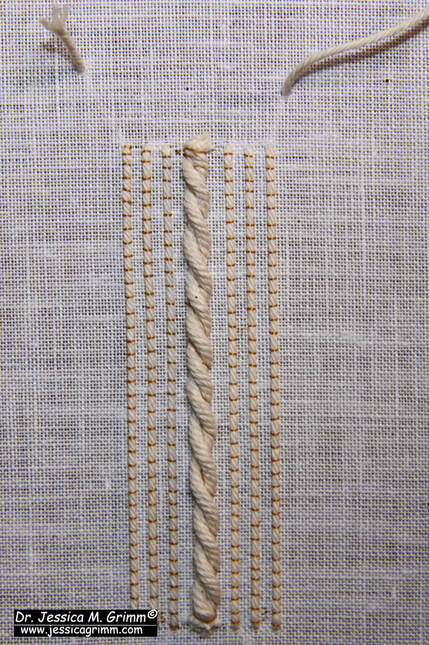|
In the past two weeks, we have explored the early 15th century gold embroidery from Venice, Italy. One of its characteristics is the ornate orphrey borders with the twisted columns. I've always been curious how they were made! So out came the cotton padding threads and the gold threads and off I went. This kind of embroidery is best done on a slate frame. If you would like a reminder of what this is and how to set it up, please have a look at my instruction videos. Next, you will need to attach your string padding. The original uses two different kinds of padding. There seems to be something like soft cotton underneath the twisted columns. And a thinner string is used as padding on either side. I've used two thicknesses of the same cotton string for the padding. In order for the gold threads to be able to sit crisp on the padding, make sure that you couch down your padding well. The gold thread used in the original embroidery is a passing thread. In my recreation, I've opted for Stech 70/80, which is comparable to passing #3. I was also curious to know what the difference would be between a gilt and a real gold thread. I worked the main part of the sample with the cheaper gilt and the bottom section with the real gold (more yellow). I prefer the real gold :). It is a tat better at going and staying where I want it to go and stay. The result is a bit crisper. Still not as crisp as the original, but closer. If you have the opportunity to try different brands of passing thread, please do and see how they behave. Working over this amount of padding will cause slight problems. Although you place a couching stitch over the gold and in the 'groove' of the twisted column, the gold is not very securely attached in this place. The twisted padding threads are also very round. Your gold thread wants to 'escape' and roll off. This is also visible in the original embroidery. And it comes as no surprise that the embroidery is most damaged in this area.
My Journeyman and Master Patrons will find a downloadable PDF with this stitch sample on my Patreon page. As I am travelling in the coming week, there will be no blog post next Monday. I will be visiting various Diocesan Museums in Germany and the Netherlands. All my Patrons will be able to virtually travel with me as I hope to be able to post some pictures along the way. There will also be a meeting of the Medieval Embroidery Study Group for my Master Patrons on Saturday the 2nd of December at 19h CET. Details can be found on my Patreon page.
4 Comments
From last week's blog post, you might have gotten the idea that Venetian goldwork embroideries from the early 15th century are somewhat plentiful. They are not. However, another magnificent piece was exhibited at Castello del Buonconsiglio in Trento, Northern Italy. Some parts are remarkably modern in their appearance. Parts of the design could be easily adapted for modern goldwork embroidery. Let's have a look at the medieval eye candy. The embroidered chasuble cross on the red chasuble comes originally from the Church of San Pantalon in Venice. It is now kept in the Frari church in Venice. From the top, we see the Resurrection of Christ, Gregory the Great, Saint Jerome and Saint Augustine with angels in the side arms of the cross. There is another corresponding chasuble cross on the front. Unfortunately, the way it was exhibited did not permit the viewer to see the front as well. On that chasuble cross are depicted Saint Mark (tentative identification), Saint Ambrose and Saint Catherine with John the Baptist and a male saint on the side arms of the cross. Personally, I love this type of iconography. We have the four fathers of the church: Gregory the Great, Ambrose, Augustine of Hippo and Jerome. All four are seen as important theologians of the late Roman-Early medieval church (that's roughly 800-1000 years before this embroidery was made). Then there are Saint Catherine and John the Baptist. Two very important saints seen throughout the Middle Ages all over Europe. The story of Saint Catherine is also all about learning, philosophy and theology. A chasuble with a high IQ. As you can see from the orphrey of Jerome in the picture above, the embroidery is a bit damaged. The orphrey has warped quite a bit and this made it difficult to take good pictures. The shaded inky underdrawing is very fine and of exceptional quality. And so is the embroidery (made with gilded silver foil around a yellow silk core or silver foil around a white silk core). The goldwork is very accurate and the silken directional split stitches are very small and regular. As seen on last week's embroidery, the frame around the orphrey is padded. And we see the twisted padded columns again. And did you spot the 'measles'? This time, they are not located on the clothing (except for the hat of Jerome, see above). Instead, they decorate the multi-coloured arches (not really or nue as there is no shading; there is on the armour of the soldiers in the Resurrection scene) beneath the pinnacles and the large blue dome. In this case, the 'measles' are made over a disc of pressed paper. The same padding material is also used in the thicker parts of the pinnacles. Paper was a rather 'modern' material. Its use in Italian embroidery shows that trading ports such as Venice had easier access to it. It is not seen as a padding material in embroideries from Northern Europe. I absolutely love this background! It looks so very modern and oriental. This would make for a lovely modern embroidery design.
If you would like to see more downloadable pictures of this amazing embroidery and if you would like to join our Zoom call on the early 15th century embroideries from Venice, then please consider becoming a Patron. Your monthly contribution keeps this blog and my research going. Thank you very much! Literature Prá, Laura Dal; Carmignani, Marina; Peri, Paolo (Eds.) (2019): Fili d'oro e dipinti di seta. Velluti e ricami tra Gotico e Rinascimento. Trento: Castello del Buonconsiglio. In September 2019, I visited the exquisite exhibition "Fili d'oro e dipinti di seta" in the Castello del Buonconsiglio in Trento, Northern Italy. Together with the 2015 exhibition in the Catharijneconvent and the 2016 Opus Anglicanum exhibition in the V&A, this was one of those 'must-see' exhibitions. This one visit provided me with research material for several years. Especially as I was allowed to take as many pictures as I liked. As long as you don't use flash, the textiles absolutely do not mind. Today, we are going to look at some early Venetian embroidery. It includes some techniques unique to the Venetian embroidery workshops. Let's dive in! As you can see in the picture above, the cope is no longer an actual vestment. Only the mutilated orphreys have survived. They were used secondarily on an antependium which was probably made at the end of the 19th century. The orphreys were taken of this newer antependium in 2006 when they were restored and applied to a neutral backing. The orphreys represent three pairs of saints facing each other, a smaller square orphrey that would have sat on the neck of the wearer and which connected the two sets of three and part of the cope's hood with the Coronation of the Virgin. Identifiable among the saints are: John the Baptist (top left), James the Great (top right), Bartholomew or Peter (middle left) and Saint Jerome (square in the middle). The embroideries were made in a Venetian embroidery workshop around AD 1410-1417. When you look at the outer garments of the figures, it looks like they have the measles. These 'measles' are actually characteristic of Venetian embroidery. The 'measles' are made by covering a metal disc, with a central or off-centre hole (think spangle/sequin), with gold thread. Some discs are made of pressed paper. The gold threads that cover the discs are worked in gimped couching, but with an underside couching stitch. Proof again that underside couching is not exclusively English. Keeping the gold threads from rolling off the edges of the padding was probably no small feat! Another characteristic of Venetian embroidery is the elaborate dimensional frame around the orphreys. String padding is used to achieve the different textures. By using strings with different thicknesses, they could achieve several 'levels' in the frame.
In general, many different embroidery techniques are used in these Italian embroideries from the Middle Ages. There is beautiful (directional) split stitch in silk, there is laid work, diaper couching and trellises. Or nue is absent as that was probably invented in the Southern Netherlands/Northern France and had not yet made its way to Italy. If you would like to see more (detailed) pictures of these nine orphreys, then please visit my Patreon page. Journeyman and Master members will find 23 images which can be downloaded. Literature Prá, Laura Dal; Carmignani, Marina; Peri, Paolo (Eds.) (2019): Fili d'oro e dipinti di seta. Velluti e ricami tra Gotico e Rinascimento. Trento: Castello del Buonconsiglio. |
Want to keep up with my embroidery adventures? Sign up for my weekly Newsletter to get notified of new blogs, courses and workshops!
Liked my blog? Please consider making a donation or becoming a Patron so that I can keep up the good work and my blog ad-free!
Categories
All
Archives
July 2024
|
Contact: info(at)jessicagrimm.com
Copyright Dr Jessica M. Grimm - Mandlweg 3, 82488 Ettal, Deutschland - +49(0)8822 2782219 (Monday, Tuesday, Friday & Saturday 9.00-17.00 CET)
Impressum - Legal Notice - Datenschutzerklärung - Privacy Policy - Webshop ABG - Widerrufsrecht - Disclaimer
Copyright Dr Jessica M. Grimm - Mandlweg 3, 82488 Ettal, Deutschland - +49(0)8822 2782219 (Monday, Tuesday, Friday & Saturday 9.00-17.00 CET)
Impressum - Legal Notice - Datenschutzerklärung - Privacy Policy - Webshop ABG - Widerrufsrecht - Disclaimer















 RSS Feed
RSS Feed